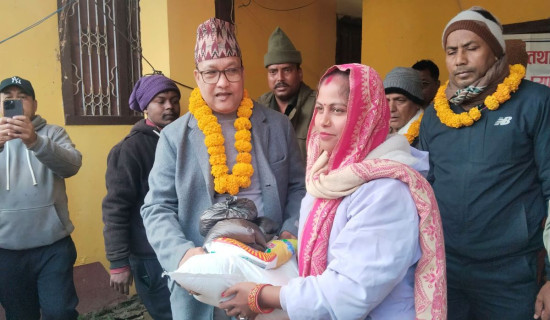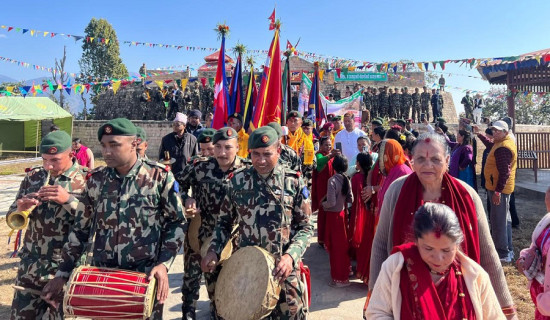- Thursday, 8 January 2026
Parties’ Mercurial Acts Erode Credibility
Nepali political parties present a rich tapestry of patterns, not because of their common characteristics but because of their shifting positions and slippery temper from ideological determinism. It is important to know what dominates the terms and terrains of political contests, what adjudicates their rival aspirations and interests and how economic and partisan interests compete with each other for lower-order of profit and power maximisation, not the delivery of high-order public good. Apparently, Nepali political parties are driven more by the aspirations of people. It provides a basis for leadership struggle for power and legitimacy to rule. One thing is obvious: left-centre-right political spectrum and bi-polar adversarial politics have become incongruous, superfluous and redundant.
Antagonistic conflict can arise if parties are formed along class lines. Multiparty dispensation of varied societal interests makes such conflict improbable. Proportional election in a culturally diverse nation ensures no triumph of a single party to form its own government. The marked shift in political contradiction seems to pivot between the centralised and decentralised operation of political parties. In this context, resolution of many national issues of national security, political stability, governance, transitional justice, need satisfaction, economy, education, health, climate change, foreign policy, etc. requires the cooperation of all politically significant forces. The second is class mobilisation hardly gains salience in the nation.
Partisan imperative
Partisan imperative to win electoral games has made them multi-focused to various identity groups of society. Party politics has, therefore, lost its normative boundaries and unbounded its effects on non-political areas. The formation of a new coalition government of ten political parties, including Nepali Congress and independents under the leadership of Prime Minister Pushpa Kamal Dahal ‘Prachanda,’ chairman of CPN-Maoist Centre, marks first the unity of opposites, a unity against their potential rivals CPN-UML and Rastriya Prajatantra Party. The first is organisationally strong and has faithful followers in the government, media and civil society and diverts its flames to grassroots mission evoking nationalist fury while the latter is replenishing its clout out of system contradictions propelling transitional politics. Yet, the ruling coalition is drafting common minimum policies and struggling for the formation of a full cabinet.
It has, however, cracked open the possibility of tension among the heterodox nature of leaders in the bargaining for important ministerial berths to steer the course of governance in a constitutional direction. It is yet to be seen how long it will take to break the current stasis on the basis of reflection and inquiry and the coalition partners will be able to optimise their interests and identities in a middle path between the deficiencies of political will, coordination and desirable performance. Nepali parties need to invent their correct logos defining which class or interest group they represent so that politics and public policies are geared to uplift them. Their all-inclusive concerns have lost clear priority and focus and representation of societal cleavages for attention, debate and action.
This shows that only the sensation of incentives drives the behaviour of ordinary Nepalis as opposed to what great poet Laxmi Prasad Devkota expressed in his poem “Nepalis are the citizens of the world.” Yet he was fully aware of how short-term interest enslaves their passion and blurs the long-term vision. The second is the value of democratic learning of philosophy, doctrines and policies, not exclusive power orientation. The paradoxes of Nepali politics arise from conceptual, ideological, leadership and organisational culture of political parties. Their tendency to aggregate and segregate societal interests and their articulation on the basis of “we” and “they” have parted with the inclusive character of democracy and ability of Nepalis to exercise the principle of “affected” in the decision making choice of leaders.
Political parties have an uneven level of support to the Nepali constitution which has made it difficult to promote rule-based order in the nation. One can find its causes in a lack of general consensus on the constitution and, consequently, conflicting socialisation and mobilisation of political cadres and supporters, not discovering common ground for collective action. Party schools are left in an imprecise state to socialise and politicise Nepalis on public orientation and public works. Party competition thus rests not on teaching how to win policy battles to make national life satisfying but only the power of organisational and leadership command over the people. One can thus find the declining value of the public sphere for rational discussion for opinion building and policy inputs.
Political communication and political education are vital tools to shape democratic character, political acculturation and public morality. These make them active and attentive citizens not governed by apolitical or anti-political temptations. The growing weight of Maitighar Mandela, not the empty parliament and understaffed judiciary, has become a democratic symbol for the ordinary people to get their voice heard and heeded to whether it is conflict-victims, indebted people, raging protests of civil society, dharna of farmers for fertilisers availability and fury of the victims demanding justice. Party acolytes must have to ponder on how to restore the integrity and functions of representing, justice-dispensing and disciplining organisations so that each keeps operating under laxman rekha, remaining within the laws and boundaries of prerogatives defined for them.
So long as Nepali demos lack the power of civic competence filled with excellence, courage and virtues, party leadership will continue to exercise thought-control of critical voices, their participation will continue to face the crisis of moral choice. The third is all political parties embellish their old image when they were founded but adopting new beliefs, opinions and habits of mind, habits shaped by the sheer struggle for power and distribution of patronage to followers and clients with a lax response to both public and national interests. It has generated a contradiction between the impersonality of the state, civic and political institutions and personalised political culture. All the parties are leader-oriented and power is exercised not by deliberative institutional culture of political parties and public institutions but by the impulse of top leaders. Great Greek philosopher Aristotle deems human beings "political animal” for their ability to coexist and cooperate in the public sphere of the state.
Defending its raison d’etre against instrumental politics of interest groups, business, parties, civil society and geopolitical interests is, therefore, essential to protect its writ and capabilities and ability to secure the interests of the marginalised and powerless. It is the state that fills the void of ungoverned space by the political system, government and parties, executes laws and policies in the entire Nepali society and restrains predatory forces penetrating its internal political evolution causing perpetual instability where no government can fulfill its terms of rule. Inability to balance foreign policy can easily drag the nation into the abyss of geopolitical tensions and drain its political stability, national will and self-determination cultivating and perpetuating instrumental politics. One general trend of Nepali party politics is that leadership orientation to market forces and geopolitical interests have hybridized the nation’s parties, polity and political culture.
The other is the inclination of union of political elites in the name of national consensus devoid of opposition to correct the malaises of government and offer alternative policies. It has marked a shift in the political culture of leadership from value-orientation to privilege. Social movements of peasants, minorities, Dalits, identity-orientation groups etc. are, therefore, precisely couched in anti-institutional politics. They aim to challenge the political status quo and use unconventional means for political transformation, demanding a redistributive regime and a pluralist sense of justice. They believe that inequality in the access to the institutional resources of the state, market and society can have an adverse effect on the quality of Nepali democracy.
The fourth is the ideological void that has made Nepali politics costly. The erosion of ideologies and forging of coalition of all with all in political agitation, power sharing and governance have liberated individual leaders, cadres and voters from collective ties, except the interest-based ones, and fostered a process of continuous shift in alignment, de-alignment and free-floating turning partisan bond flimsy. As a result, the sense of volunteerism and solidarity in party politics is waning except in the case of fear of loss of power and privileges. One can see its impacts in the swinging voters’ loyalty and shifting party affiliation. A lesser amount of time devoted to understanding the local problems in the deliberation of party conventions indicates a lack of inner-party democracy and growing friction and factionalism at vertical level.
As an intermediary organisation between the polity and the people, parties infinitely fractionalise the public sphere of politics, reinforced by the nation’s social, economic, demographic and geographical diversity. The elements of popular sovereignty, social inclusion and proportional representation imply less meaning if one can see how the differentiated nature of citizenship on the basis of clustering of people by the constitution itself and its practice in national political life have unsettling effects. Only citizenship-based education can spur national identity and liberate Nepalis from feudal and archaic clutches. The swamps of cacophonous orientation of people do not create a common ground for conflict resolution.
Elite dissatisfaction
Fifth, political parties are penetrating all spheres of national life, not just the axis of parliament, executive and judiciary. All constitutional bodies, economy, media, educational institutions and other public institutions of civil society lack autonomy and impersonality in their performance. It may be a turning point for Nepali democracy and leadership to know that excessive party-mindedness can easily weaken state institutions, erode its monopoly on power and make democracy defective, unable to balance individual, group-based and human rights. Political elite formation through parties has bloated its size beyond the ability of people to subsidize. And political elites are mostly superfluous, not functional, to cope with the diverse needs of society in matters of policy production, interest expression and representation of people, political communication and maintenance of feedback.
Nepali parties have origins in elite dissatisfaction with the regime, dispensation of political cleavages such as caste, class, issues of freedom and justice, democratic principles and sub-national aspirations. Consciousness along these lines is mostly for interests and power as each formulated demands in the public sphere and its justification without nurturing self-accountability. Democratic stability in Nepal requires constitutional conduct of people and leaders acquiring self-mastered life based on the idea of a resilient democratic progress, beyond prejudice and stereotypes.
(Former Reader at the Department of Political Science, TU, Dahal writes on political and social issues.)
















